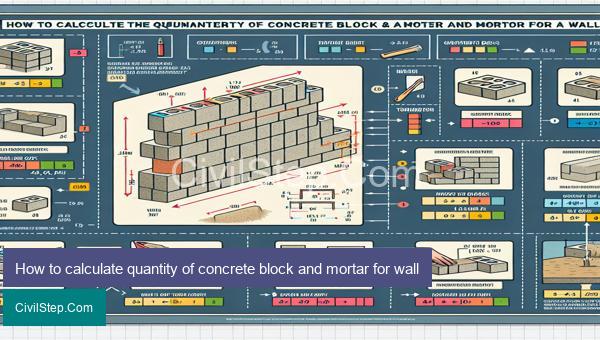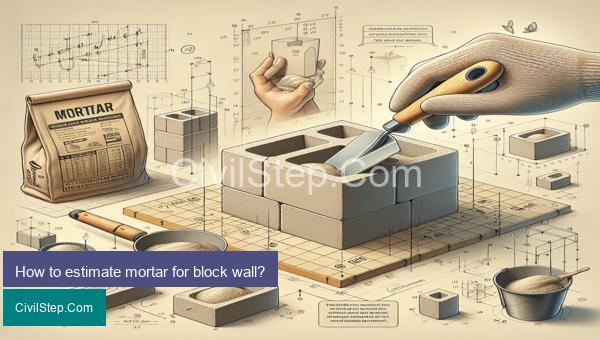
When planning to construct a wall out of concrete blocks, one of the crucial steps is to accurately calculate the quantity of blocks and mortar needed for the project. This task can seem daunting for some, especially those who are new to construction. However, having the correct knowledge and understanding of the calculation process is essential in ensuring a successful and efficient project. In this article, we will discuss all about how to calculate the quantity of concrete blocks and mortar needed for a wall, including the necessary tools, formulas, and factors to consider. By the end of this article, readers will have a thorough understanding and be equipped with the skills to accurately determine the materials needed for their concrete block wall project.
How to calculate quantity of concrete block and mortar for wall

Calculating the quantity of concrete blocks and mortar required for a wall is an essential task for any civil engineer. It helps in estimating the cost and time required for the construction project. Here, we will discuss the step-by-step process of calculating the quantity of concrete blocks and mortar for a wall.
Step 1: Determine the dimensions of the wall
The first step is to determine the dimensions of the wall, i.e., the length, width, and height. These measurements must be taken in meters to ensure accuracy. Let’s consider an example of a wall with the following dimensions: Length = 10m, Width = 3m, and Height = 3m.
Step 2: Calculate the surface area of the wall
Now, we need to find the surface area of the wall by multiplying the length and height. In our example, the surface area of the wall will be 10m x 3m = 30 sq.m.
Step 3: Determine the size of concrete blocks
The size of concrete blocks can vary, but the most commonly used size is 390mm x 190mm x 190mm. However, it is always better to check with the supplier for the exact size. For our calculation, we will take the size of the concrete block as 400mm x 200mm x 200mm.
Step 4: Determine the number of blocks required
To calculate the number of blocks required, we need to divide the surface area of the wall by the area of a single block. In our example, the surface area of the wall is 30 sq.m, and the area of a single block is 0.08 sq.m (400mm x 200mm). So, the number of blocks required will be 30 sq.m / 0.08 sq.m = 375 blocks.
Step 5: Add an extra 5-10% for wastage
It is always advisable to add an extra 5-10% to the total number of blocks required to account for any wastage during construction.
Step 6: Calculate the quantity of mortar
Mortar is used to bond the blocks together. The ratio of mortar to block is 1:6. It means that for every 1 part of cement, there are 6 parts of sand. To calculate the quantity of mortar, we need to first determine the volume of mortar required. The volume of mortar is equal to the surface area of the wall multiplied by the thickness of the mortar joint. The thickness of the mortar joint is usually taken as 10mm. So, the volume of mortar is 30 sq.m x 0.01m = 0.3 cubic meters.
Next, we need to calculate the quantity of cement and sand required. To do this, we need to use the ratio of 1:6. It means that for every 1 part of cement, we need 6 parts of sand. So, for 0.3 cubic meters of mortar, we will need 0.3/7 = 0.043 cubic meters of cement and 0.25 cubic meters of sand.
Step 7: Add an extra 5-10% for wastage
Similar to the number of blocks, we need to factor in an extra 5-10% for any wastage while calculating the quantity of cement and sand.
In conclusion, to calculate the quantity of concrete blocks and mortar required for
How to estimate mortar for block wall?

Estimating the amount of mortar required for a block wall is an essential aspect of any construction project. If too little mortar is used, the wall may not be strong enough to withstand the weight it is meant to bear. On the other hand, using too much mortar can increase construction costs unnecessarily. Therefore, accurately estimating the required amount of mortar is crucial for the success and cost-effectiveness of a block wall project. In this article, we will discuss the step-by-step process of estimating mortar for a block wall.
Step 1: Understand the components of mortar
Before we begin estimating the amount of mortar, it is crucial to understand the components that make up mortar. These include cement, sand, and water. The appropriate ratio for these components is 1:3:1, which means that for every 1 part of cement, you need 3 parts of sand and 1 part of water. This ratio may vary slightly depending on project specifications, but it is a good rule of thumb for estimating purposes.
Step 2: Calculate the volume of the wall
The first step to estimating mortar is to determine the volume of the wall. To do this, multiply the length of the wall (in feet) by the height of the wall (in feet) by the thickness of the wall (in inches). For example, if the wall is 20 feet long, 10 feet high, and 8 inches thick, the volume would be calculated as follows:
20 feet x 10 feet x 8 inches = 16,000 cubic inches
Step 3: Convert cubic inches to cubic feet
The volume of mortar is typically expressed in cubic feet, so we need to convert the volume from cubic inches to cubic feet. To do this, we divide the volume in cubic inches by 1,728 (the number of cubic inches in a cubic foot).
16,000 cubic inches / 1,728 = 9.26 cubic feet
Step 4: Determine the mortar mix ratio
As mentioned earlier, the standard mortar mix ratio is 1:3:1 (cement:sand:water). However, some projects may require a different ratio. For example, if the wall is being constructed in a high-wind area or if it needs to support heavy loads, a stronger mix with a higher cement-to-sand ratio may be necessary. Consult with the project specifications to determine the appropriate mix ratio for your project.
Step 5: Calculate the amount of cement
Now that we have the volume of mortar and the mix ratio, we can calculate the amount of cement needed. Multiply the total volume of mortar (in cubic feet) by the cement ratio. In our example, if the mix ratio is 1:3:1, the amount of cement needed would be calculated as follows:
9.26 cubic feet x 1 = 9.26 cubic feet of cement
Step 6: Calculate the amount of sand
Next, we need to determine the amount of sand needed. Multiply the volume of mortar (in cubic feet) by the sand ratio (3 in our example). This will give you the volume of sand needed in cubic feet.
9.26 cubic feet x 3 = 27.78 cubic feet of sand
Step 7: Calculate the amount of water
The final component in mortar is water, which helps to bind the cement and sand together. The amount of water needed is calculated by multiplying the volume of
Conclusion
In conclusion, calculating the quantity of concrete block and mortar for a wall is a crucial step in any construction project. By following the steps outlined in this article, individuals can accurately determine the total number of blocks and the amount of mortar needed for their wall. This ensures the success and efficiency of the construction process, saving both time and money. It is important to carefully consider various factors such as block size, mortar thickness, and mortar mix ratio in order to achieve a sturdy and durable wall. With these calculations, construction professionals and DIY enthusiasts alike can confidently proceed with their wall building project.
